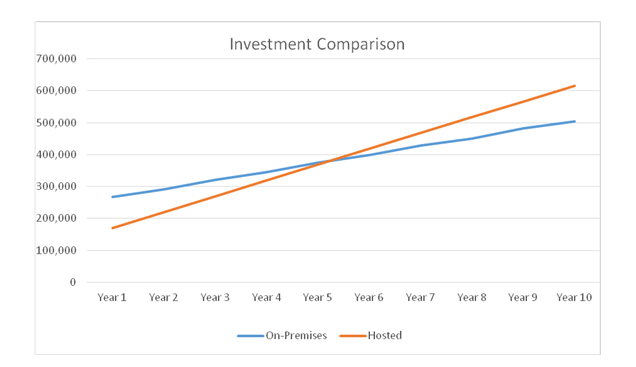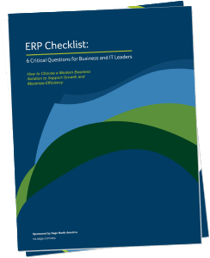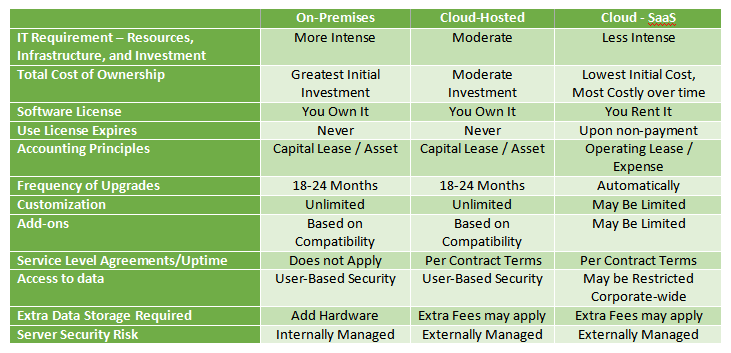Today’s ERP buyer can be overwhelmed during software evaluations with the shear amount of information available online coupled with innocuous industry buzzwords. One of the most common questions we get is “On-premises or Cloud?”.
As a general rule, we reply with “What does Cloud mean to you?”. Because essentially, Cloud might mean a hosted solution or true SaaS offering to different audiences. Based on a customer’s response to that seemingly innocent question, there can be significant differences that affect the licensing, deployment, and accessibility.
In this article, we provide a ‘cheat sheet’ and investment graph to help you navigate the merits of the On-Premises, Hosted, or Cloud debate.
What’s The Difference Anyway?
Before we get into the pros and cons of various ERP deployment options, let’s quickly refresh your understanding of the terminology.
On-premises software (sometimes abbreviated as "on-prem" software) is purchased, installed and run on computers on the premises (in the building) of the organization using the software, rather than at a remote facility, such as at a server farm or cloud somewhere on the Internet. For example, you purchase or download TurboTax and install it on your own computer.
Cloud-Hosted is a hardware management model in which the software is purchased but the installation of the software occurs on hardware servers managed at a remote facility, commonly referred to as ‘data centers’. For example, you purchase TurboTax and install it on a remote server that a 3rd party manages and you access it through a secure connection.
Cloud-Software as a Service (SaaS) is a software licensing and delivery model in which software is licensed on a subscription basis and is normally hosted by the software publisher. It is sometimes referred to as "on-demand software". For example, you subscribe to use Turbo Tax as necessary and access it through a secure connection. The software and hardware are managed by a 3rd party.
See Also: Understanding The 3 P’s of Software Selection
The Cheat Sheet Matrix
Cost of Ownership Over Time
The graph below projects the investment* of on-premises versus cloud-SaaS over a 10 year window. Industry experts predict that the replacement cycle for ERP is 7-10 years.
 * Sample pricing scenario: 20 user ERP Manufacturing solution plus project management, implementation, annual Maintenance & Support, Enhancement Upgrades, and Training. Neither scenario includes inflation, additional modules or users, nor annual price increases. No additional training for SaaS was included following the 1st year investment.
* Sample pricing scenario: 20 user ERP Manufacturing solution plus project management, implementation, annual Maintenance & Support, Enhancement Upgrades, and Training. Neither scenario includes inflation, additional modules or users, nor annual price increases. No additional training for SaaS was included following the 1st year investment.
As you can see from the graph, the initial On-Premises investment is more than the SaaS model. But over time, the lines intersect and the investment flips. The old adage, ‘pay now or pay later’ couldn’t be more true when describing the two options. Many refer to this as the ‘rent or buy’ dilemma.
In our experience, the models typically intersect between years 4 and 6 depending on the size of the organization, scope of the project, and growth with regards to user licenses and complexity so a thoughtful approach to ROI is ideal.
In conclusion, there are many variables to consider when choosing your On-Premises or Cloud deployment strategy. We recommend a coherent strategy, one defined by the CFO and CIO together to achieve the immediate and long-term business initiatives.
[feature_box style="2" only_advanced="There are no title options for the choosen style" alignment="center"]
 While You're Here ...
While You're Here ...
Grab a copy of How to Choose a New ERP System.
Choosing a new ERP system can be a daunting task – you need a system that meets your current business requirements, yet has the capability to adapt to changes. This white paper will help you ask the right questions.
Get the Guide [/feature_box]



